Diagnostics of Coherent Eddy Transport in the South China Sea Based on Satellite Observations
Abstract
:1. Introduction
2. Data and Methods
3. Results
3.1. Features of SSH Eddies in the SCS
3.2. Statistical Analysis of SSH Eddy Leakage
3.3. Dependence of Leakiness on Eddy Parameters
3.4. Coherent and Incoherent Contributions to Total Eddy Transport
4. Conclusions and Discussion
Author Contributions
Funding
Institutional Review Board Statement
Informed Consent Statement
Data Availability Statement
Acknowledgments
Conflicts of Interest
Appendix A
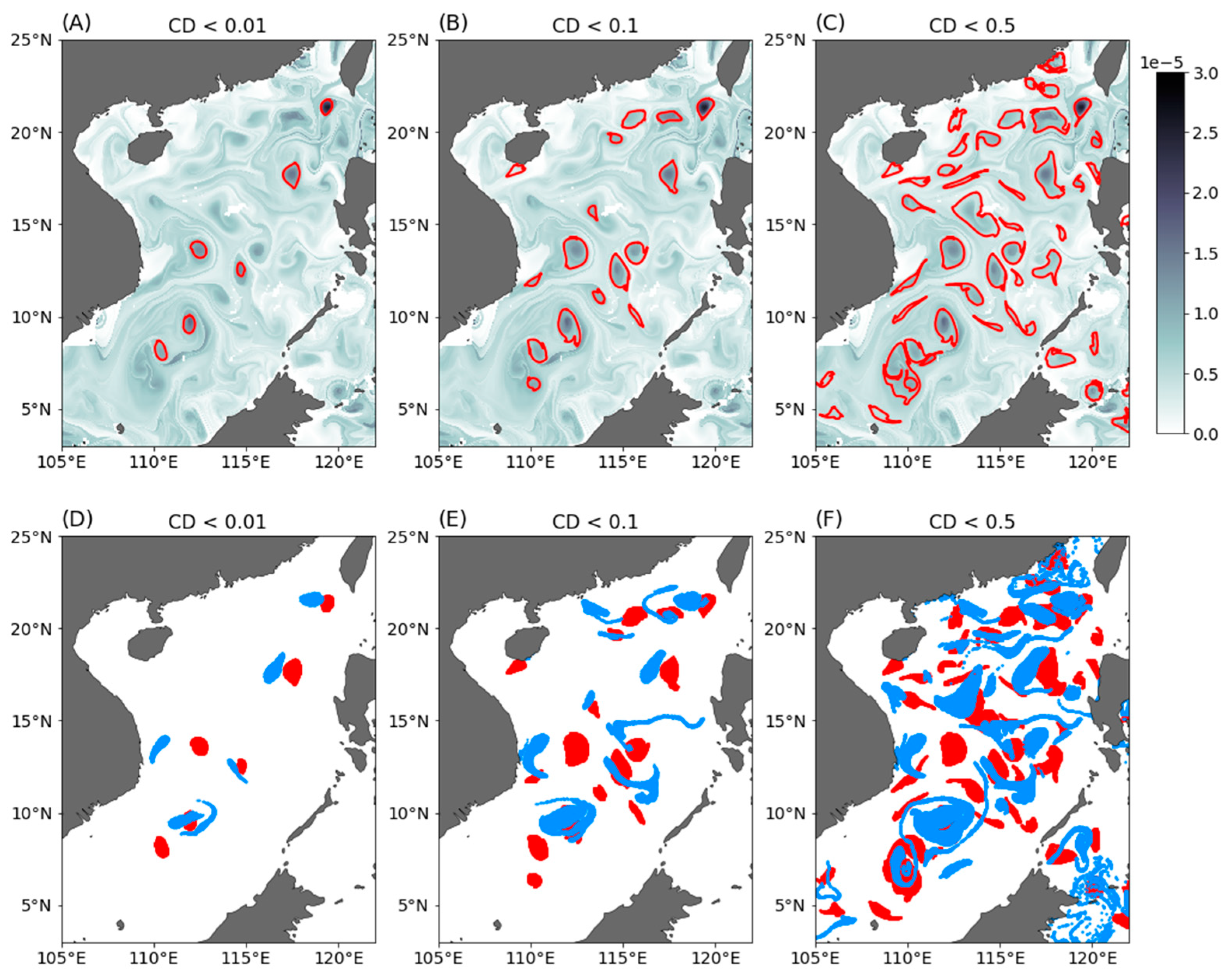
References
- Wunsch, C.; Ferrari, R. Vertical mixing, energy, and the general circulation of the oceans. Annu. Rev. Fluid Mech. 2004, 36, 281–314. [Google Scholar] [CrossRef] [Green Version]
- Fu, L.-L.; Chelton, D.; Le Traon, P.-Y.; Morrow, R. Eddy Dynamics From Satellite Altimetry. Oceanography 2010, 23, 14–25. [Google Scholar] [CrossRef] [Green Version]
- Chelton, D.B.; Schlax, M.G.; Samelson, R.M. Global observations of nonlinear mesoscale eddies. Prog. Oceanogr. 2011, 91, 167–216. [Google Scholar] [CrossRef]
- Jayne, S.R.; Marotzke, J. The dynamics of ocean heat transport variability. Rev. Geophys. 2001, 39, 385–411. [Google Scholar] [CrossRef] [Green Version]
- Thompson, A.F.; Heywood, K.; Schmidtko, S.; Stewart, A. Eddy transport as a key component of the Antarctic overturning circulation. Nat. Geosci. 2014, 7, 879–884. [Google Scholar] [CrossRef]
- Busecke, J.J.M.; Abernathey, R.P. Ocean mesoscale mixing linked to climate variability. Sci. Adv. 2019, 5, eaav5014. [Google Scholar] [CrossRef] [Green Version]
- Liu, Q.; Kaneko, A.; Jilan, S. Recent progress in studies of the South China Sea circulation. J. Oceanogr. 2008, 64, 753–762. [Google Scholar] [CrossRef]
- Zheng, Q.; Hu, J.; Ho, C.-R.; Xie, L. Advances in Research of Regional Oceanography of the South China Sea: Overview; World Scientific Publishing Company: Singapore, 2020; pp. 1–18. [Google Scholar] [CrossRef]
- Chen, G.; Hou, Y.; Chu, X. Mesoscale eddies in the South China Sea: Mean properties, spatiotemporal variability, and impact on thermohaline structure. J. Geophys. Res. Ocean. 2011, 116, 711–720. [Google Scholar] [CrossRef]
- He, Q.; Zhan, H.; Cai, S.; He, Y.; Huang, G.; Zhan, W. A New Assessment of Mesoscale Eddies in the South China Sea: Surface Features, Three-Dimensional Structures, and Thermohaline Transports. J. Geophys. Res. Ocean. 2018, 123, 4906–4929. [Google Scholar] [CrossRef]
- Liu, Y.; Dong, C.; Liu, X.; Dong, J. Antisymmetry of oceanic eddies across the Kuroshio over a shelfbreak. Sci. Rep. 2017, 7, 6761. [Google Scholar] [CrossRef] [Green Version]
- Ding, R.; Xuan, J.; Zhang, T.; Zhou, L.; Zhou, F.; Meng, Q.; Kang, I.-S. Eddy-induced Heat Transport in the South China Sea. J. Phys. Oceanogr. 2021, 51, 2329–2349. [Google Scholar] [CrossRef]
- Haller, G. Lagrangian coherent structures. Annu. Rev. Fluid Mech. 2015, 47, 137–162. [Google Scholar] [CrossRef] [Green Version]
- Dong, C.; McWilliams, J.C.; Liu, Y.; Chen, D. Global heat and salt transports by eddy movement. Nat. Commun. 2014, 5, 3294. [Google Scholar] [CrossRef] [PubMed] [Green Version]
- Zhang, Z.; Wang, W.; Qiu, B. Oceanic mass transport by mesoscale eddies. Science 2014, 345, 322–324. [Google Scholar] [CrossRef] [PubMed]
- Wang, G.; Su, J.; Chu, P. Mesoscale eddies in the South China Sea observed with altimeter data. Geophys. Res. Lett. 2003, 30. [Google Scholar] [CrossRef] [Green Version]
- Xiu, P.; Chai, F.; Shi, L.; Xue, H.; Chao, Y. A census of eddy activities in the South China Sea during 1993–2007. J. Geophys. Res. Ocean. 2010, 115. [Google Scholar] [CrossRef] [Green Version]
- Hu, J.; Gan, J.; Sun, Z.; Zhu, J.; Dai, M. Observed three-dimensional structure of a cold eddy in the southwestern South China Sea. J. Geophys. Res. Ocean. 2011, 116. [Google Scholar] [CrossRef]
- Lin, X.; Dong, C.; Chen, D.; Liu, Y.; Yang, J.; Zou, B.; Guan, Y. Three-dimensional properties of mesoscale eddies in the South China Sea based on eddy-resolving model output. Deep Sea Res. Part I: Oceanogr. Res. Pap. 2015, 99, 46–64. [Google Scholar] [CrossRef]
- Zhang, Y.; Liu, Z.; Zhao, Y.; Wang, W.; Li, J.; Xu, J. Mesoscale eddies transport deep-sea sediments. Sci. Rep. 2014, 4, 5937. [Google Scholar] [CrossRef]
- Wang, X.; Li, W.; Qi, Y.; Han, G. Heat, salt and volume transports by eddies in the vicinity of the Luzon Strait. Deep Sea Res. Part I Oceanogr. Res. Pap. 2011, 61, 21–33. [Google Scholar] [CrossRef]
- Zhang, Z.; Zhao, W.; Qiu, B.; Tian, J. Anticyclonic Eddy Sheddings from Kuroshio Loop and the Accompanying Cyclonic Eddy in the Northeastern South China Sea. J. Phys. Oceanogr. 2017, 47, 1243–1259. [Google Scholar] [CrossRef] [Green Version]
- Yang, Y.; Zeng, L.; Wang, Q. How Much Heat and Salt Are Transported Into the South China Sea by Mesoscale Eddies? Earth’s Futur. 2021, 9, e2020EF001857. [Google Scholar] [CrossRef]
- Okubo, A. Horizontal dispersion of floatable particles in the vicinity of velocity singularities such as convergences. Deep Sea Res. Oceanogr. Abstr. 1970, 17, 445–454. [Google Scholar] [CrossRef]
- Weiss, J. The dynamics of enstrophy transfer in two-dimensional hydrodynamics. Phys. D Nonlinear Phenom. 1991, 48, 273–294. [Google Scholar] [CrossRef]
- Nencioli, F.; Dong, C.; Dickey, T.; Washburn, L.; McWilliams, J.C. A Vector Geometry–Based Eddy Detection Algorithm and Its Application to a High-Resolution Numerical Model Product and High-Frequency Radar Surface Velocities in the Southern California Bight. J. Atmos. Ocean. Technol. 2010, 27, 564–579. [Google Scholar] [CrossRef]
- Abernathey, R.; Haller, G. Transport by Lagrangian Vortices in the Eastern Pacific. J. Phys. Oceanogr. 2018, 48, 667–685. [Google Scholar] [CrossRef] [Green Version]
- Shadden, S.C.; Lekien, F.; Marsden, J.E. Definition and properties of Lagrangian coherent structures from finite-time Lyapunov exponents in two-dimensional aperiodic flows. Phys. D Nonlinear Phenom. 2005, 212, 271–304. [Google Scholar] [CrossRef]
- D’Ovidio, F.; Isern-Fontanet, J.; López, C.; Hernández-García, E.; García-Ladona, E. Comparison between Eulerian diagnostics and finite-size Lyapunov exponents computed from altimetry in the Algerian basin. Deep Sea Res. Part I Oceanogr. Res. Pap. 2009, 56, 15–31. [Google Scholar] [CrossRef] [Green Version]
- Haller, G.; Hadjighasem, A.; Farazmand, M.; Huhn, F. Defining coherent vortices objectively from the vorticity. J. Fluid Mech. 2016, 795, 136–173. [Google Scholar] [CrossRef] [Green Version]
- Haller, G.; Beron-Vera, F.J. Coherent Lagrangian vortices: The black holes of turbulence. J. Fluid Mech. 2013, 731. [Google Scholar] [CrossRef] [Green Version]
- Wang, Y.; Olascoaga, M.J.; Beron-Vera, F.J. Coherent water transport across the South Atlantic. Geophys. Res. Lett. 2015, 42, 4072–4079. [Google Scholar] [CrossRef] [Green Version]
- Liu, T.; Abernathey, R.; Sinha, A.; Chen, D. Quantifying Eulerian Eddy Leakiness in an Idealized Model. J. Geophys. Res. Ocean. 2019, 124, 8869–8886. [Google Scholar] [CrossRef] [Green Version]
- Adcroft, A.; Campin, J.M.; Doddridge, S.D.; Evangelinos, C.; Ferreira, D.; Follows, M.; Scott, J. MITgcm documentation. Release Checkp. 2018, 19, 67a-12-gbf23121. [Google Scholar]
- Abernathey, R.P.; Marshall, J. Global surface eddy diffusivities derived from satellite altimetry. J. Geophys. Res. Ocean. 2013, 118, 901–916. [Google Scholar] [CrossRef]
- He, Y.; Xie, J.; Cai, S. Interannual variability of winter eddy patterns in the eastern South China Sea. Geophys. Res. Lett. 2016, 43, 5185–5193. [Google Scholar] [CrossRef]
- He, Y.; Feng, M.; Xie, J.; He, Q.; Liu, J.; Xu, J.; Chen, Z.; Zhang, Y.; Cai, S. Revisit the Vertical Structure of the Eddies and Eddy-Induced Transport in the Leeuwin Current System. J. Geophys. Res. Ocean. 2021, 126, e2020JC016556. [Google Scholar] [CrossRef]
- Faghmous, J.H.; Frenger, I.; Yao, Y.; Warmka, R.; Lindell, A.; Kumar, V. A daily global mesoscale ocean eddy dataset from satellite altimetry. Sci. Data 2015, 2, 150028. [Google Scholar] [CrossRef] [Green Version]
- Zhang, W.; Wolfe, C.L.P.; Abernathey, R. Role of Surface-Layer Coherent Eddies in Potential Vorticity Transport in Quasigeostrophic Turbulence Driven by Eastward Shear. Fluids 2019, 5, 2. [Google Scholar] [CrossRef] [Green Version]
- Nan, F.; Xue, H.; Chai, F.; Shi, L.; Shi, M.; Guo, P. Identification of different types of Kuroshio intrusion into the South China Sea. Ocean Dyn. 2011, 61, 1291–1304. [Google Scholar] [CrossRef]
- Wang, G.; Chen, D.; Su, J. Winter Eddy Genesis in the Eastern South China Sea due to Orographic Wind Jets. J. Phys. Oceanogr. 2008, 38, 726–732. [Google Scholar] [CrossRef]
- Cheng, X.; Xie, S.-P.; Du, Y.; Wang, J.; Chen, X.; Wang, J. Interannual-to-decadal variability and trends of sea level in the South China Sea. Clim. Dyn. 2015, 46, 3113–3126. [Google Scholar] [CrossRef] [Green Version]
- Chelton, D.B.; DeSzoeke, R.A.; Schlax, M.G.; El Naggar, K.; Siwertz, N. Geographical variability of the first baro-clinic Rossby radius of deformation. J. Phys. Oceanogr. 1998, 28, 433–460. [Google Scholar] [CrossRef]
- Huang, R.; Xie, L.; Zheng, Q.; Li, M.; Bai, P.; Tan, K. Statistical analysis of mesoscale eddy propagation velocity in the South China Sea deep basin. Acta Oceanol. Sin. 2020, 39, 91–102. [Google Scholar] [CrossRef]
- Reynolds, O. The Sub-Mechanics of the Universe; University Press: Cambridge, UK, 1903; Volume 3. [Google Scholar]
- Early, J.J.; Samelson, R.M.; Chelton, D.B. The Evolution and Propagation of Quasigeostrophic Ocean Eddies. J. Phys. Oceanogr. 2011, 41, 1535–1555. [Google Scholar] [CrossRef]
- Tarshish, N.; Abernathey, R.; Zhang, C.; Dufour, C.O.; Frenger, I.; Griffies, S. Identifying Lagrangian coherent vortices in a mesoscale ocean model. Ocean Model. 2018, 130, 15–28. [Google Scholar] [CrossRef]
- LaCasce, J. Statistics from Lagrangian observations. Prog. Oceanogr. 2008, 77, 1–29. [Google Scholar] [CrossRef]
- Klocker, A.; Ferrari, R.; LaCasce, J.H. Estimating Suppression of Eddy Mixing by Mean Flows. J. Phys. Oceanogr. 2012, 42, 1566–1576. [Google Scholar] [CrossRef] [Green Version]
- Bennett, A.F. Relative Dispersion: Local and Nonlocal Dynamics. J. Atmos. Sci. 1984, 41, 1881–1886. [Google Scholar] [CrossRef] [Green Version]
- Frenger, I.; Münnich, M.; Gruber, N.; Knutti, R. Southern Ocean eddy phenomenology. J. Geophys. Res. Ocean. 2015, 120, 7413–7449. [Google Scholar] [CrossRef] [Green Version]
- Yang, Q.; Zhao, W.; Liang, X.; Dong, J.; Tian, J. Elevated Mixing in the Periphery of Mesoscale Eddies in the South China Sea. J. Phys. Oceanogr. 2017, 47, 895–907. [Google Scholar] [CrossRef]
- Yang, S.; Xing, J.; Chen, D.; Chen, S. A modelling study of eddy-splitting by an island/seamount. Ocean Sci. 2017, 13, 837–849. [Google Scholar] [CrossRef] [Green Version]
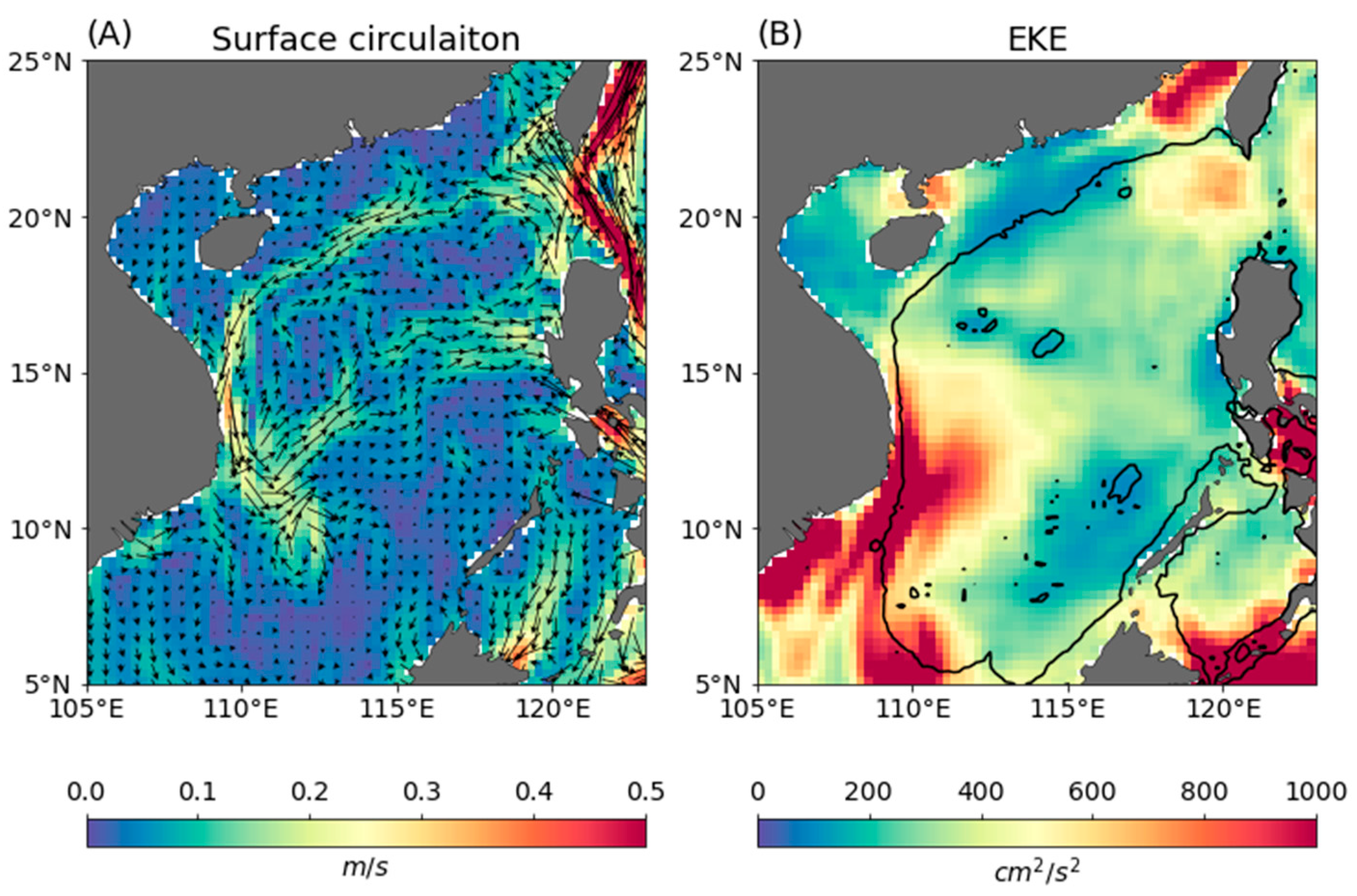
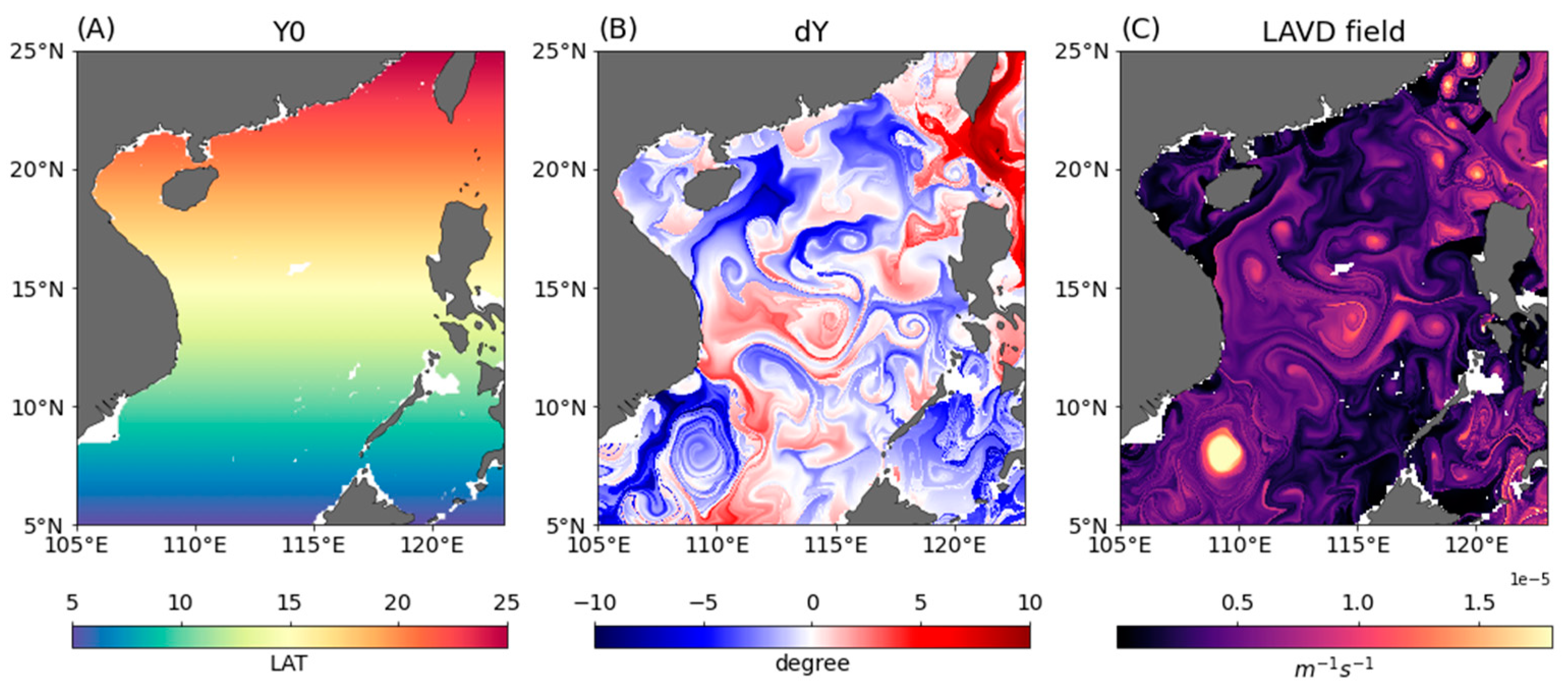
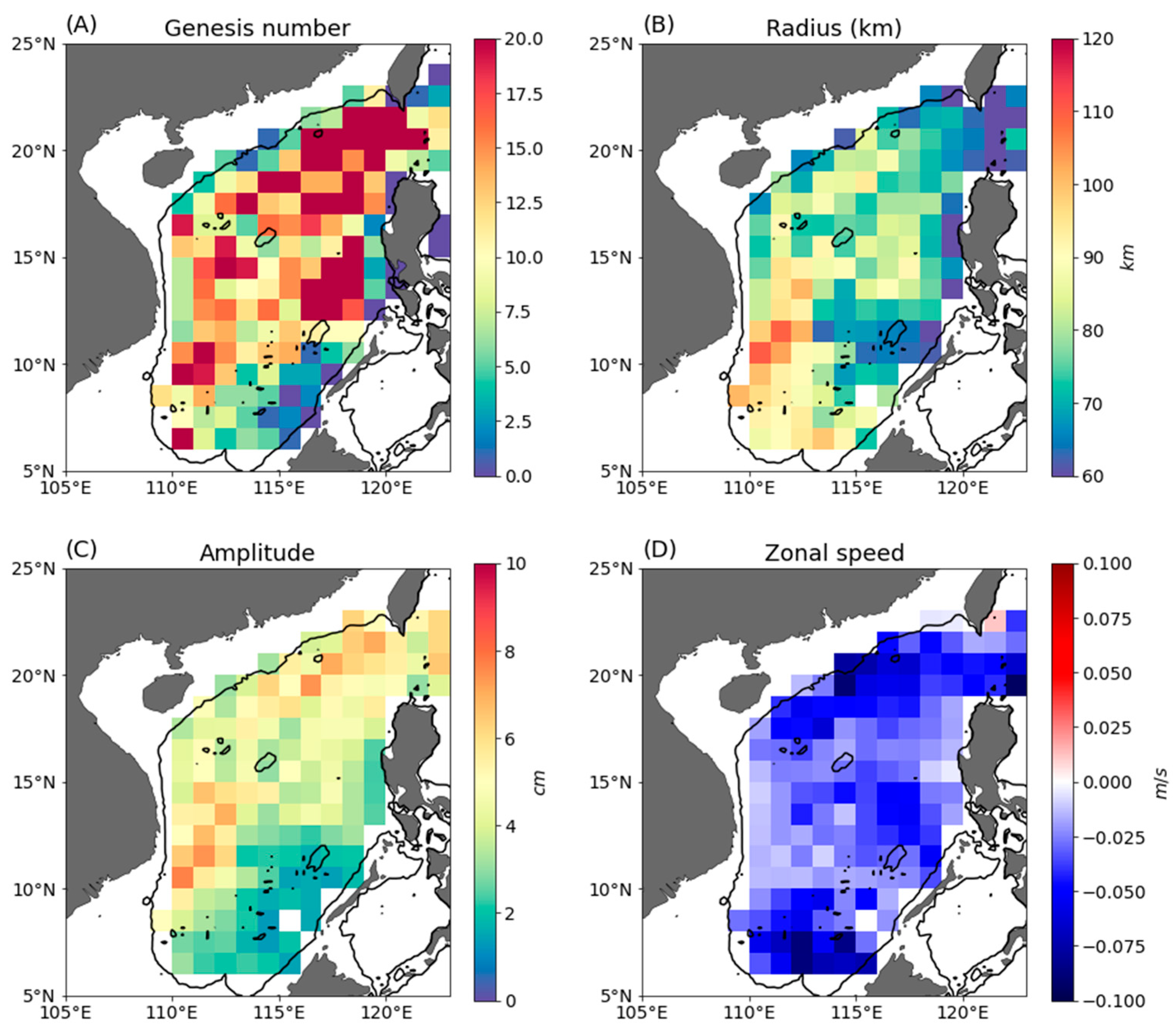
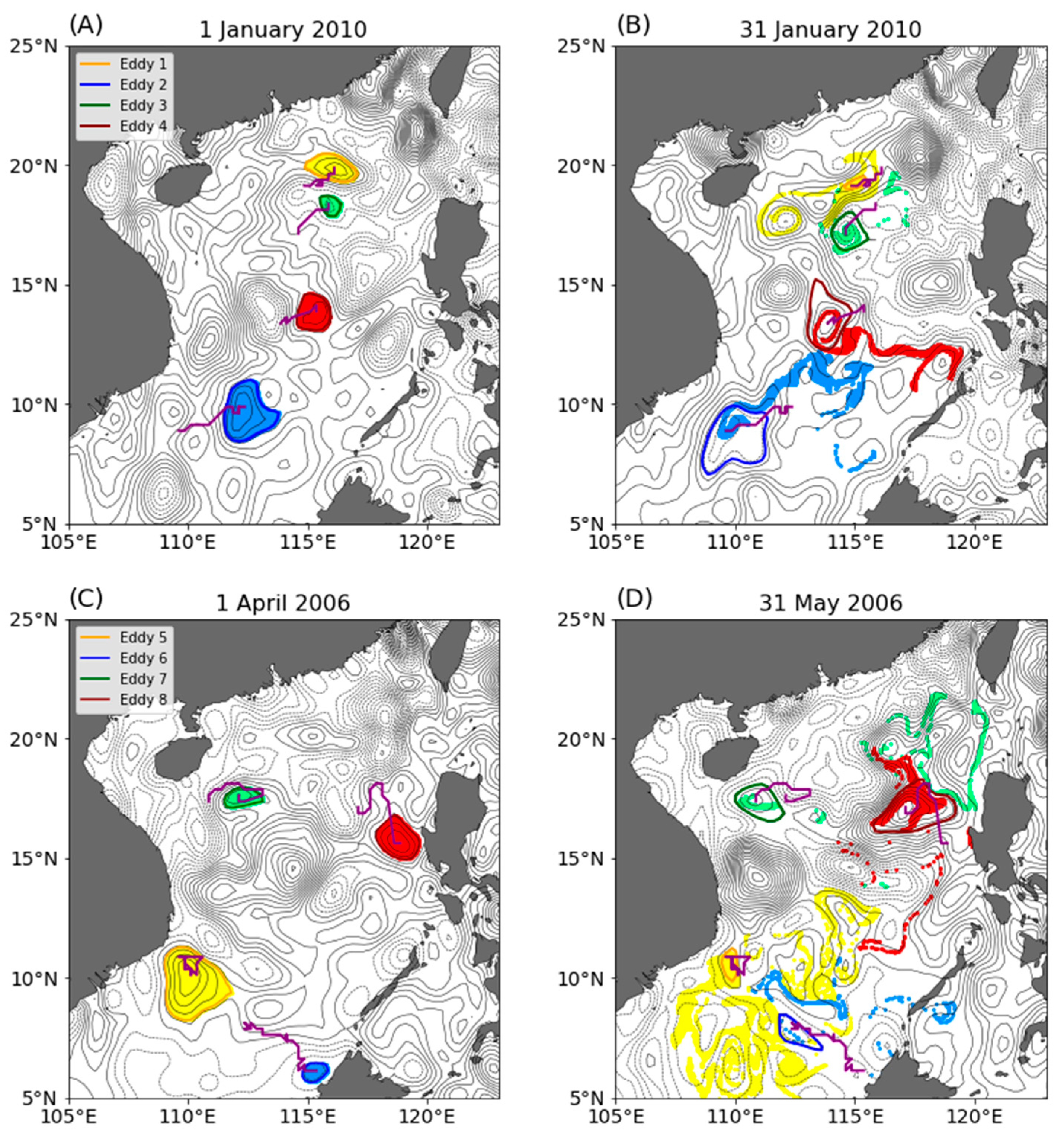
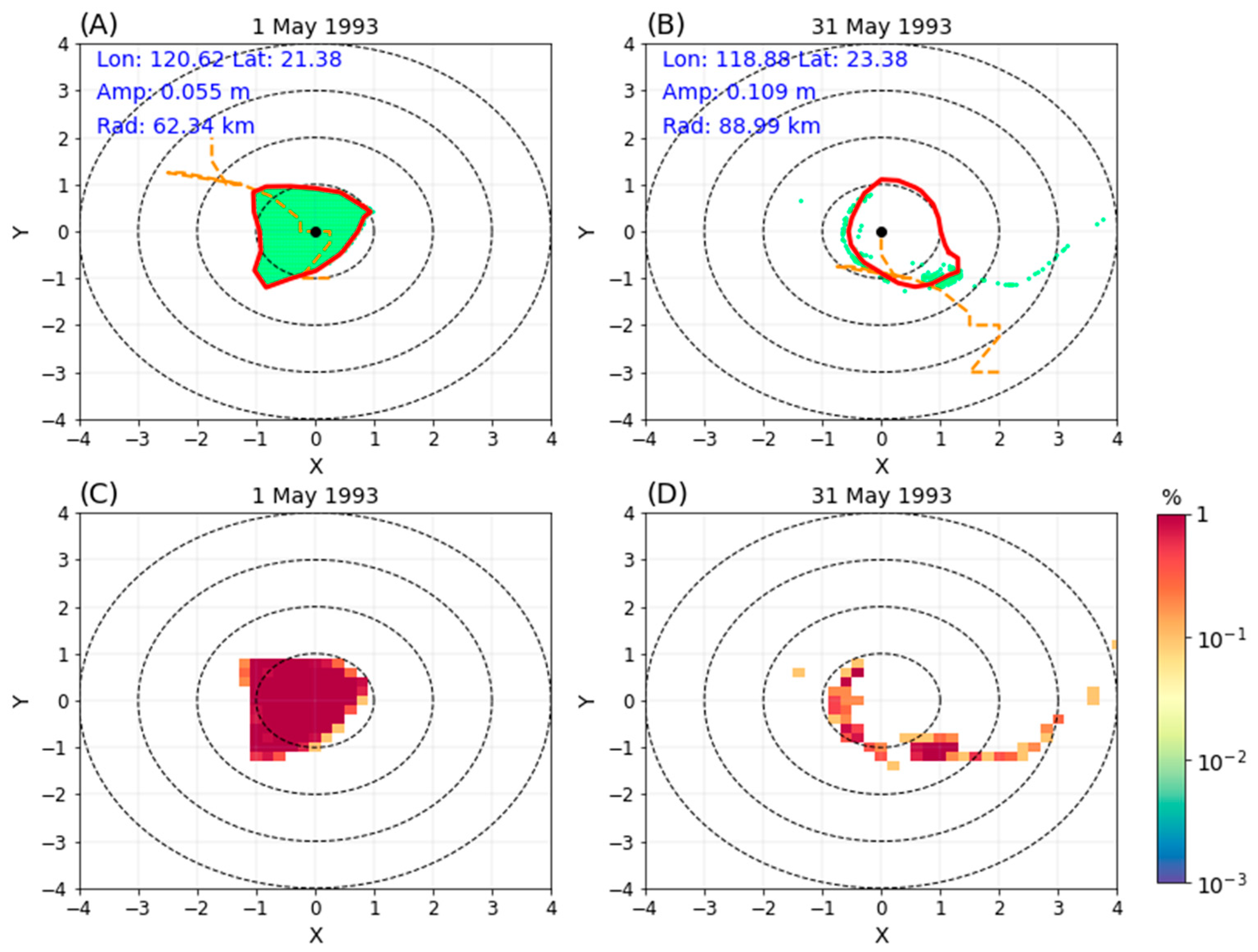
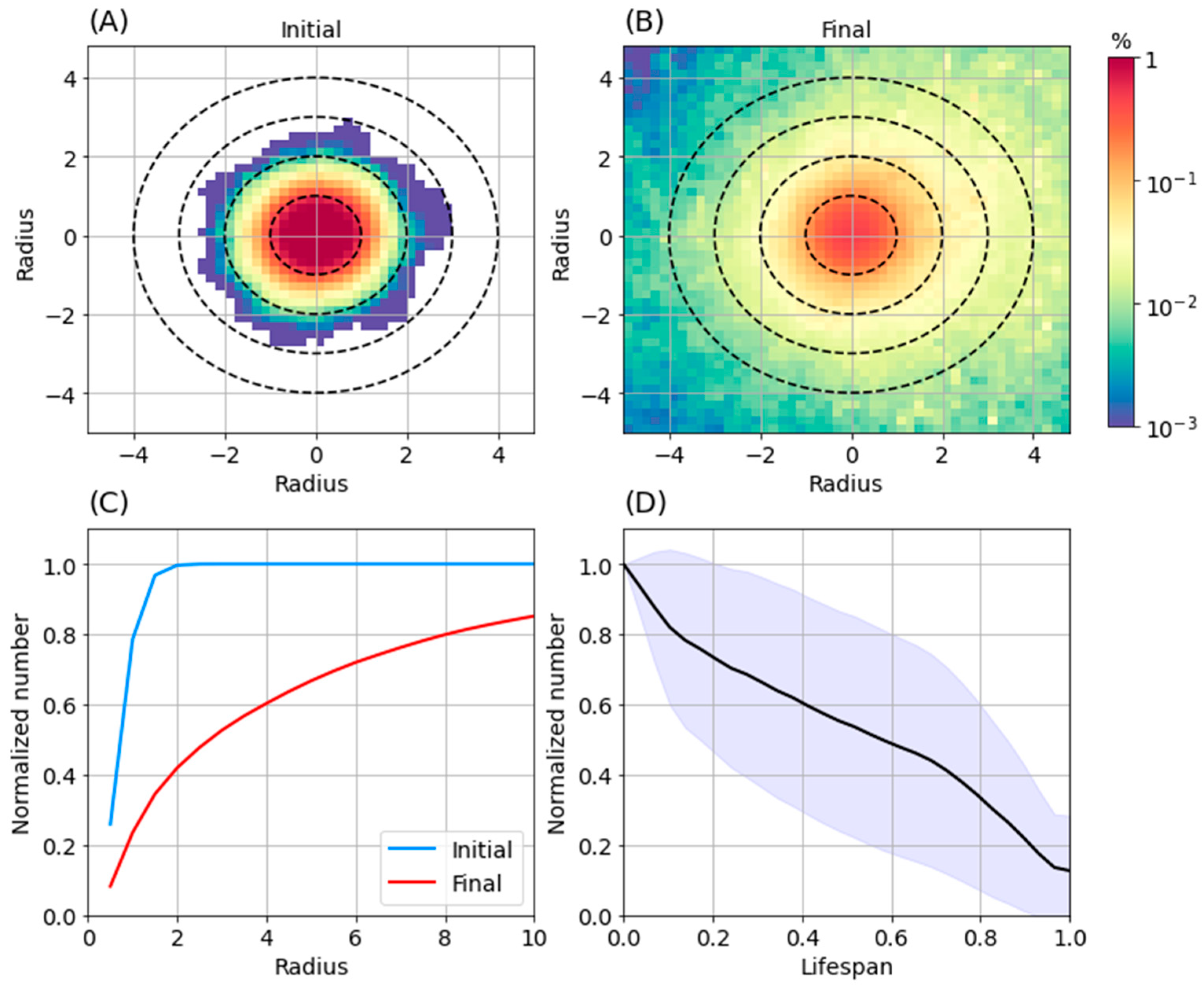
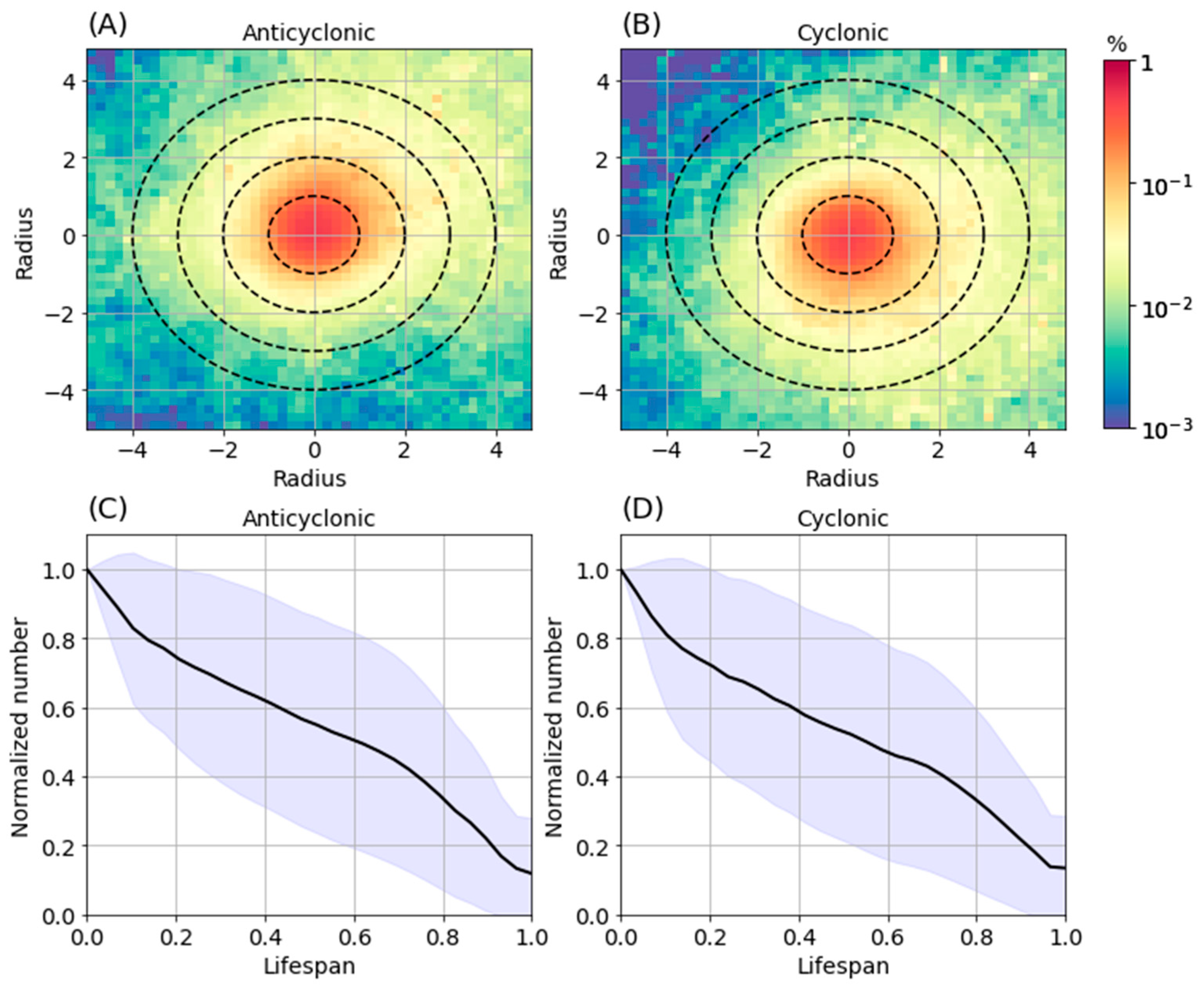
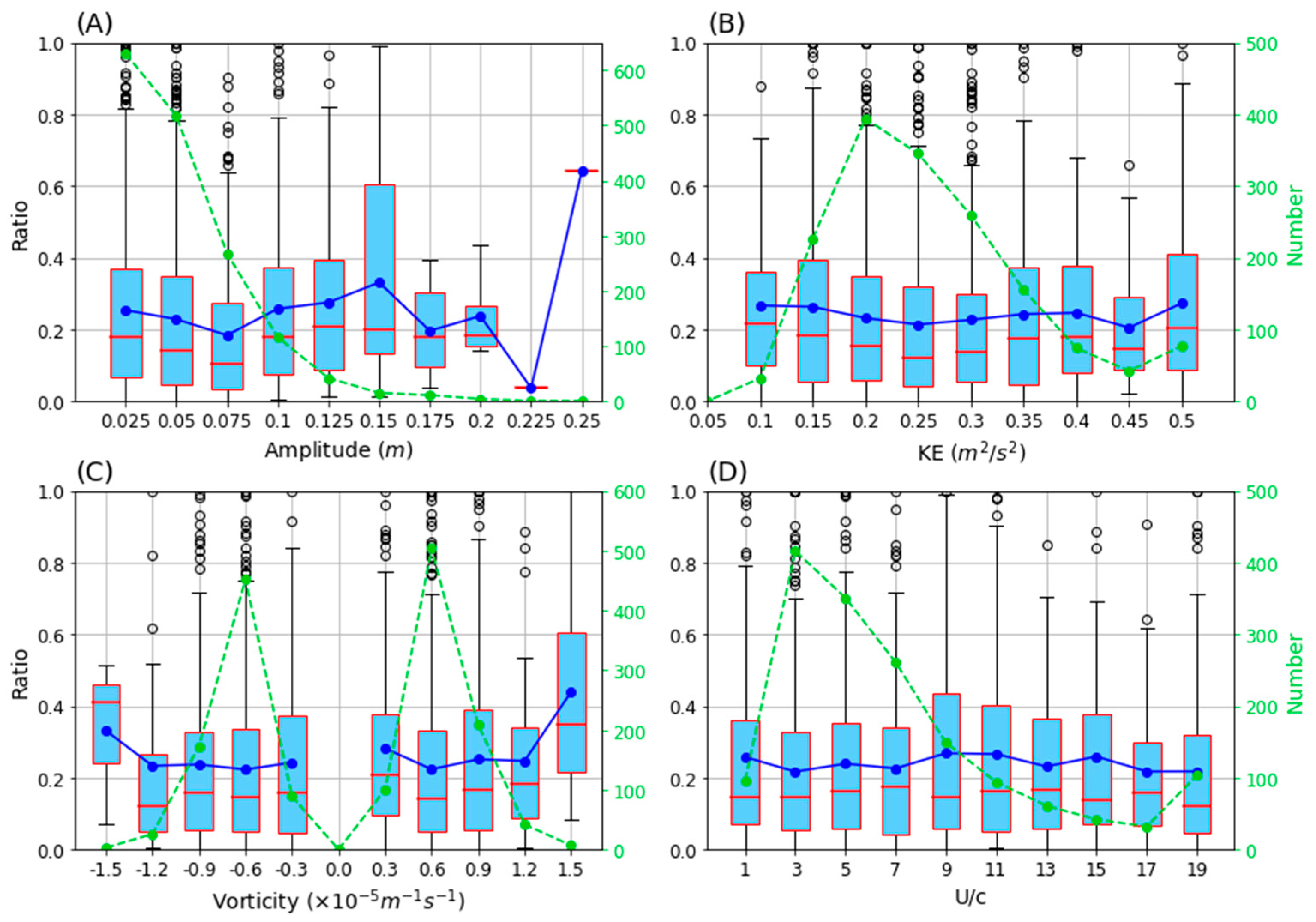
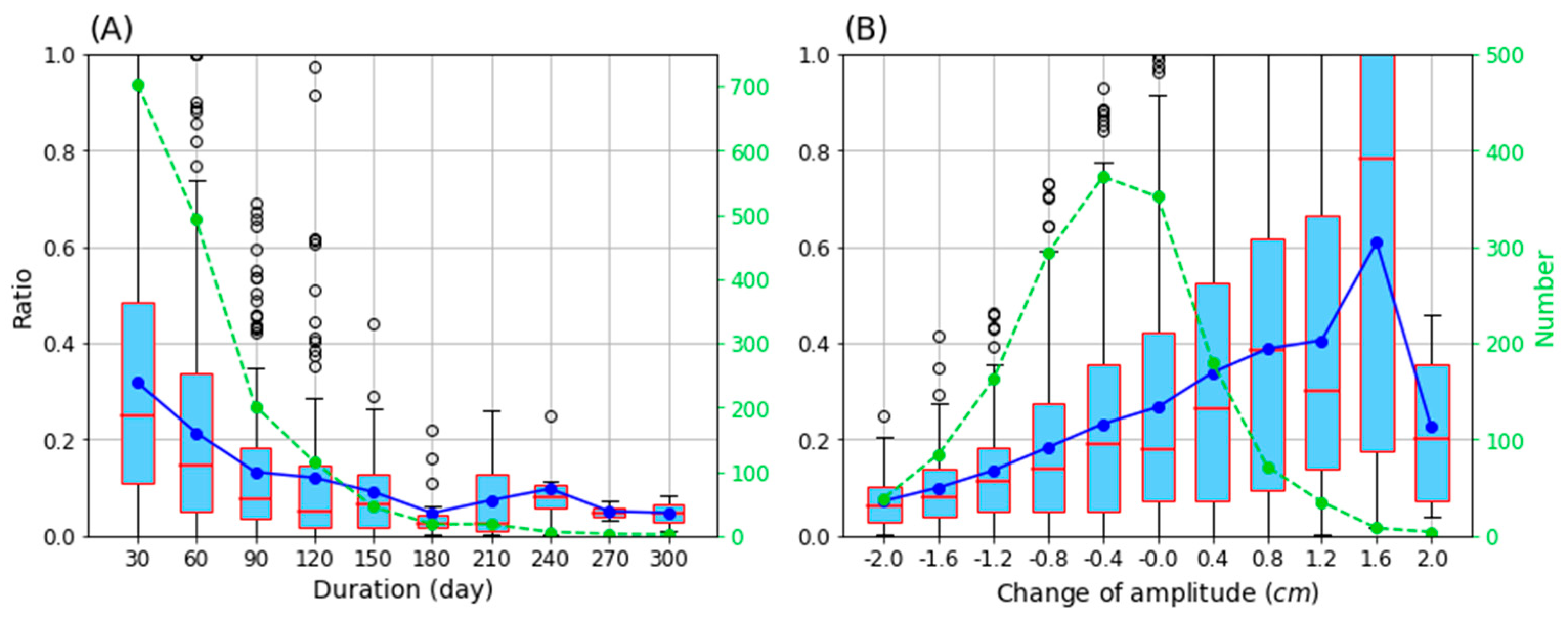
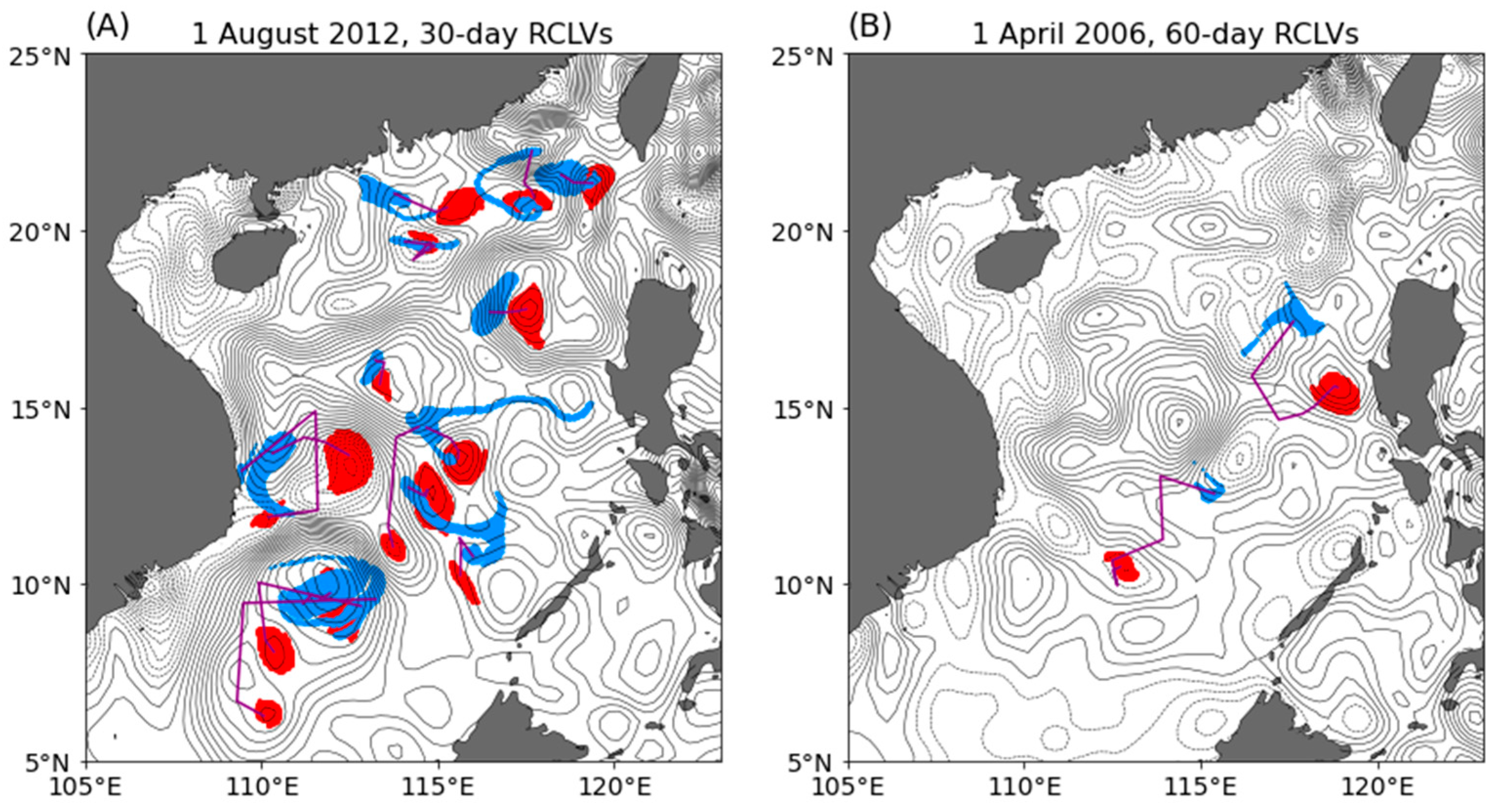
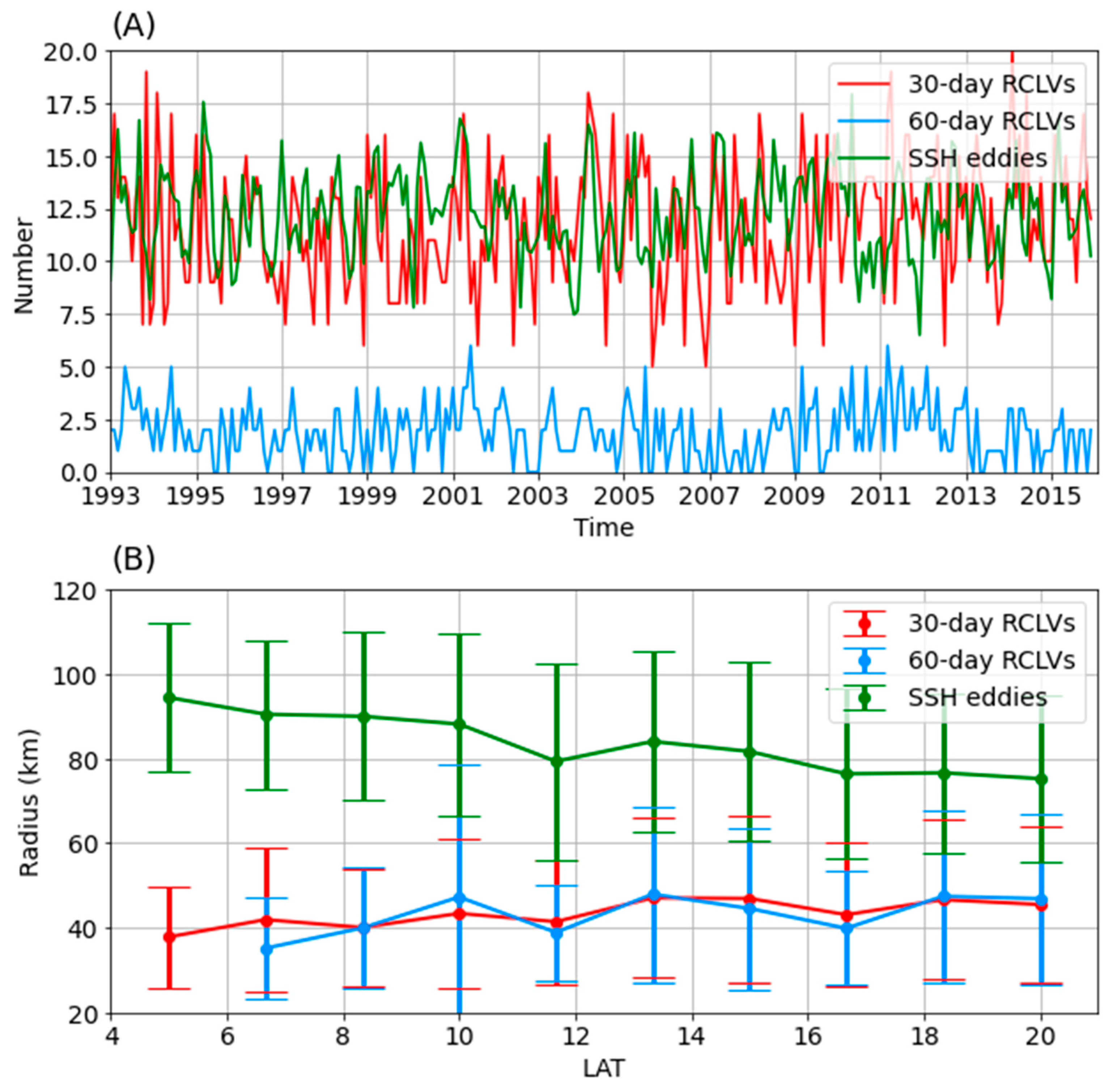
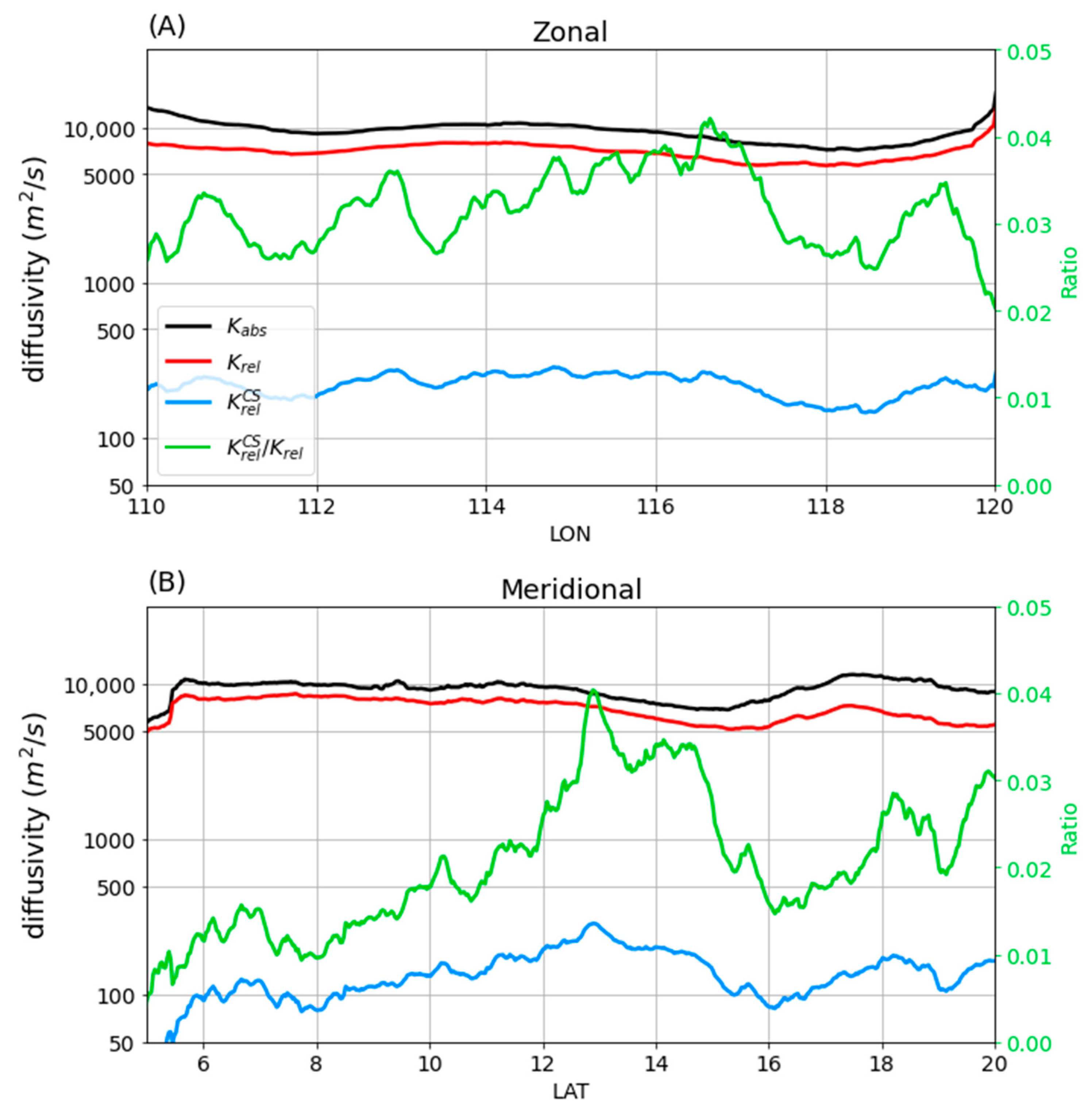
Publisher’s Note: MDPI stays neutral with regard to jurisdictional claims in published maps and institutional affiliations. |
© 2022 by the authors. Licensee MDPI, Basel, Switzerland. This article is an open access article distributed under the terms and conditions of the Creative Commons Attribution (CC BY) license (https://creativecommons.org/licenses/by/4.0/).
Share and Cite
Liu, T.; He, Y.; Zhai, X.; Liu, X. Diagnostics of Coherent Eddy Transport in the South China Sea Based on Satellite Observations. Remote Sens. 2022, 14, 1690. https://doi.org/10.3390/rs14071690
Liu T, He Y, Zhai X, Liu X. Diagnostics of Coherent Eddy Transport in the South China Sea Based on Satellite Observations. Remote Sensing. 2022; 14(7):1690. https://doi.org/10.3390/rs14071690
Chicago/Turabian StyleLiu, Tongya, Yinghui He, Xiaoming Zhai, and Xiaohui Liu. 2022. "Diagnostics of Coherent Eddy Transport in the South China Sea Based on Satellite Observations" Remote Sensing 14, no. 7: 1690. https://doi.org/10.3390/rs14071690
APA StyleLiu, T., He, Y., Zhai, X., & Liu, X. (2022). Diagnostics of Coherent Eddy Transport in the South China Sea Based on Satellite Observations. Remote Sensing, 14(7), 1690. https://doi.org/10.3390/rs14071690





